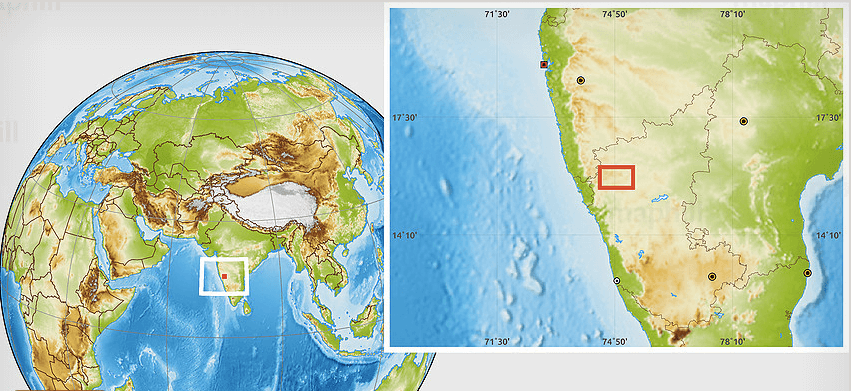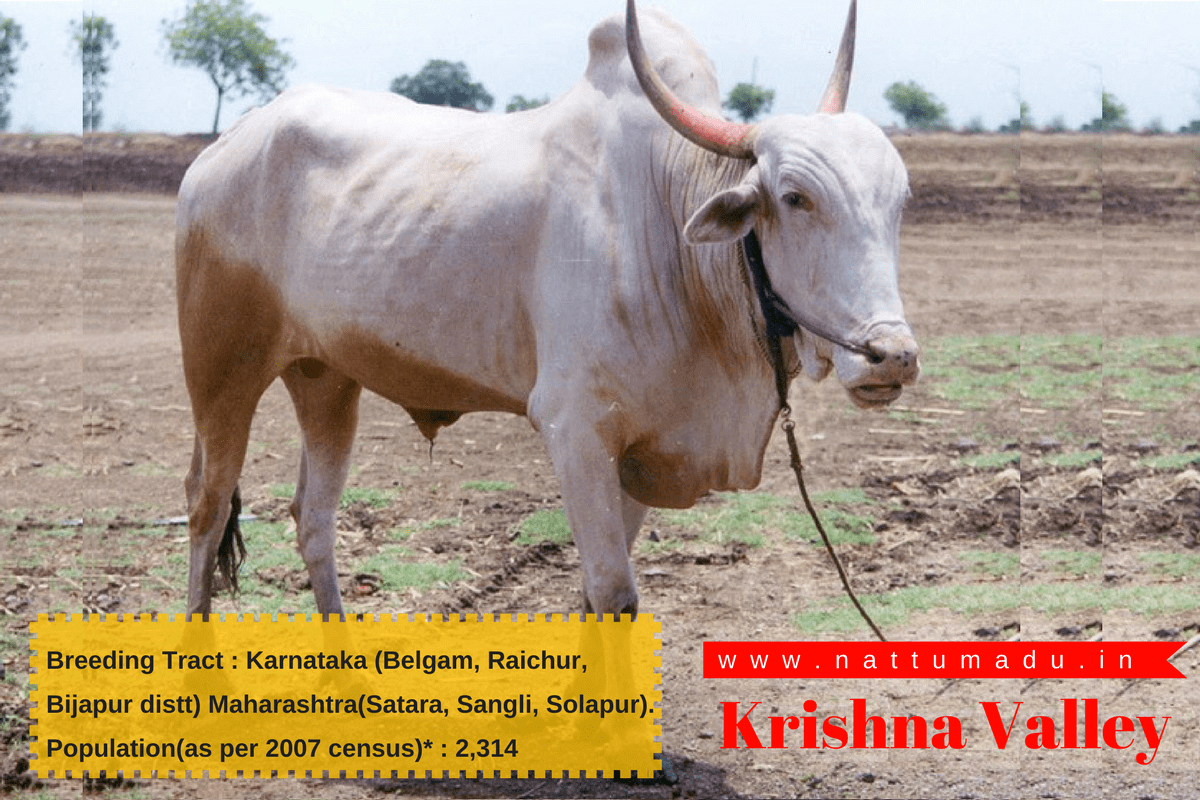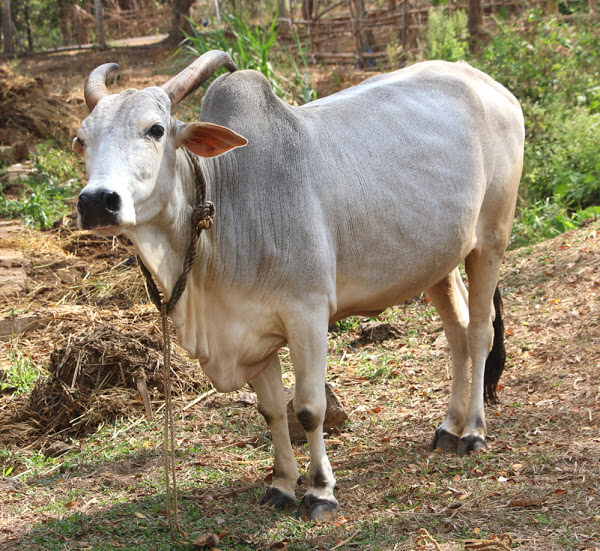
Krishna Valley cattle (Kannada: god) is a breed of cattle native to North Karnataka region in India. It is known to have originated in the areas drained by the Krishna, Ghataprabha and Malaprabha rivers of the Bijapur, Bagalkot and Belgaum districts.

It is a draught breed mainly used for agricultural purposes. The bulls are known for strength and endurance and the cows are moderate milk yielders.

Need Support:
We are currently searching for additional photographs and information on this breed. If you have materials which we could borrow or if you know of a potential source please contact us using the comment form below.
Krishna Valley cattle in India: status, characteristics and utility
S.M.K. Karthickeyan, R. Saravanan & P. Thangaraju
Department of Animal Genetics and Breeding, Madras Veterinary College, Chennai 600 007, Tamil Nadu, India.
Summary
The Krishna Valley breed of cattle is a draught breed able to withstand extremely hot, humid climatic conditions and which has the capacity to undertake heavy work in the black cotton soil in the valleys of the Krishna river in India. Their home track is restricted to a few taluks (divisions within a district) of the northern parts of Karnataka. The distinguishing morphological features of the breed are the presence of a black-coloured muzzle and black shades dispersed over the body with the lower half of the scrotum also being black in colour. The average values for height, body length and chest girth are 116.4±1.2, 128.4±2.0 and 144.7±2.0 cm in cows; and 150.5±0.5, 146.0±3.0 and 191.0±1.0 cm in bullocks, respectively. The cytogenetic investigation revealed the normal characteristics of cattle chromosomes (2n=60). The microsatellite alleles occurred at frequencies of 0.0208 (ILSTS005) to 0.7604 (ETH152) with the polymorphism information content (PIC) values in the range of 0.3856 (ETH152) to 0.7725 (ILSTS034). The breed has a relatively long productive life as the number of calvings can go up to twelve. As the number of animals of this breed remaining is only in the order of a few hundred, conservation measures are to be taken to avoid the extinction of this valuable germplasm.
Introduction
The Krishna Valley breed of cattle is well known for its draught qualities and is used exclusively in the black cotton soil in the valleys of the river Krishna. It was also reported to be present in adjacent river areas such as Ghataprabha and Malaprabha in the Karnataka and Maharashtra states in India (Anonymous, 1926). The breed was distributed in the districts of Satara, Sangali and Solapur in the Maharashtra and Belgaum, Bijapur and Raichur districts of Karnataka (Nivsarkar et al., 2000). But a pilot survey conducted recently by Ramesha et al. (2001) indicated a shift in the breeding tract of this breed from Maharashtra and Karnataka to northern Karnataka alone. Only a few hundred true to type animals are now found in and around the villages of the Jamkhandi, Mudhol and Athani taluks (divisions within a district) of northern Karnataka. With the background described, this paper demonstrates the importance of the breed in the black cotton soil, its characteristics with regard to physical, cytogenetic and molecular markers and its population status with respect to conservation measures required for the breed.
Origin and History
During the last two decades of the nineteenth century, some of the kings of the Southern Mahratta country (which lies in the watershed areas of the rivers Krishna, Ghatapabha and Malaprabha), tried to evolve a powerful bullock for agricultural purposes for use in the sticky black cotton soil (Joshi and Phillips, 1953). According to Singh and Singh (1936), Ongole cattle were undoubtedly the breed, which played the most prominent role in the evolution of Krishna Valley cattle. It was claimed that Gir and possibly Kankrej cattle from Gujarat state, Ongole cattle from Madras Province (now the areas in Andhra Pradesh state) and local cattle having Mysore–type blood were used to evolve the Krishna Valley breed. The king of Sangli, at one time a well-known breeder of Krishna Valley cattle, contributed substantially in making judicious use of all these strains to produce the desired type of animal. Though there was a wide variation in the characteristics, the massive size of the resulting animals was the chief dominating factor which attracted the attention of the cultivators.
Breeding Tract and Status
Ramesha et al. (2001) in their survey reported that the breeding tract of this breed was restricted to a few villages of the Jamkhandi, Mudhol and Athani taluks of northern Karnataka. In a recent visit made by the authors during February 2005, less than fifty animals were found in and around the villages of Jamkhandi in Bagalkot district (a part of the breeding tract). This finding is in agreement with Ramesha et al. (2001) who found only a few hundred animals in the entire breeding tract. The animals of this type were also scattered scarcely in other taluks such as Mudhool, Bilagi, Bagalkot and Badami of Bagalkot districts. Good specimens of Krishna Valley cattle are available in Mudurakhandi, Kallolli and Savalagi villages in Jamkhandi taluk. The marked decline in the number of Krishna Valley cattle marks a critical and alarming situation, which is evidenced by the shrinking size of the breeding tract and confinement of these animals to only a few regions of northern Karnataka. One of the main reasons for this is the lack of availability of breeding Krishna Valley bulls resulting from the preference of farmers for the Khillari breed of cattle which is more attractive and also massive in appearance. Not much effort had been made to preserve the Krishna Valley draught breed. The other possible reason could be the mechanization of agricultural operations in a few areas. Furthermore, most of the farmers had started selling their Krishna Valley animals due to a continuous drought prevailing in the track. But few doses of semen samples have been preserved in the Semen Bank in Hassarghatta, Bangalore, in the National Dairy Research Institute, in Adugodi, and in Bangalore and Central Semen Collection Centre, in Dharwad in Karnataka state.
The herd size of Krishna Valley cattle found in villages ranges from one to three. The Krishna Valley animals are not maintained in situ in any government organizations or livestock farms. The Indian Council of Agricultural Research (ICAR) has recently taken steps to conserve the Krishna Valley germplasm through the National Bureau of Animal Genetic Resources in Karnal, Haryana. Interestingly, in one of the Goshalas (non-governmental organizations maintaining different breeds of livestock in India) situated in Bangalore, more than 25 Krishna Valley cattle are maintained and are effectively acting as the real conservation centre (Figure 2). The breeding of the cattle is carried out through artificial insemination with the semen of the same breed, but no genetic improvement measures are undertaken for Krishna Valley cattle.
Ecological Settings
The home tract of Krishna Valley cattle is the plateau east of the Western Ghats. The tract extends over an area lying between latitudes 15o 8° and 17o 8° N and longitudes 74o and 78o E (Ramesha et al., 2001). The altitude ranges from 1800 to 2500 feet above mean sea level (MSL). The soils of the area fall into three categories viz. red soils in the hills, widely distributed and highly fertile black soils and light gray soils. In general, the climate is dry. The cold and dry season lasts from the middle of October to the middle of February. The summer season extends from February to June. During the months of April and May, it is considerably hotter. The rainy season usually occurs from June to the middle of October. The annual rainfall ranges from 30 to 50 inches.
Land Holding and Agriculture
The land holding capacity of the farmers ranges from two to ten acres and some farmers do not use the land for agriculture. Canal irrigation is employed in most places and some areas are rain fed and make use of bore well irrigation. Among the agricultural crops grown in the area, wheat is the major crop followed by the others such as sorghum, sugarcane, sunflower, cotton, turmeric and maize. Banana plantations can also be found in the breeding tract of Krishna Valley cattle.
source: fao.org
Read More: Other Native cattle
For More information and purchase on different indigenous breeds
Alambadi Cattle | Amrit Mahal Cattle | Bachaur cattle | Bargur Cattle | Gir Breed |Kasaragod Dwarf Cattle | Kherigarh Cattle | Krishna Valley cattle | Malnad Gidda Cattle | Mewati Breed | Ongole breed cattle | Ponwar Breed | Pulikulam Cattle | Umblachery Cattle | Vechur Cattle Breed
Read More: Native Dog breed
For More information on Indian native dog breeds.
Banjara Greyhound | Bully kutta mastiff | Chippiparai Hound | Gaddi Kutta mastiff | Indian Spitz | Jonangi breed | Kanni hound dog | Kombai/Combai hound dog | Mudhol Hound | Pandikona Hound | Rajapalayam Hound | Rampur Hound
Also Read : Other Blog
How to Recognise Native British Cattle Breeds | The American Bison | Recognized indigenous cattle breeds of India | List of Bos Indicus Breeds – Zebu Breed | First Domesticated Cattle in the World : Origin of Modern Cows Traced | 40 million cows to get Aadhaar like number at cost of Rs 50 crore in 1st phase : Budget 2018 | Registration of livestock/poultry breeds rises to 169: Govt | Chennai to host expo of indigenous native cattle breeds on Jan 6 and 7. | Kerala Sets up a special reproduction centre to help grow Vechur cattle population | Andhra pradesh well poised to become a seed hub, says Bill Gates | Using Cow Dung of Indigenous Breeds, This Farmer Makes Lakhs from Organic Papaya | Kampala to host 2017 livestock show | Cargill to plough millions into animal nutrition business in India | Supreme Court issues notice to Tamil Nadu government on PETA plea against jallikattu | Haryana govt plans PGs for cattle to boost milk production | Molecular Characterisation of Rathi and Tharparkar Indigenous Cattle (Bos indicus) | Embryo transfer technology to be used to carry out 440 embryo transfers in cattle in 9 days | ‘Rettamalai Ondikaruppu’ Temple Bull , is no more | Decline in indigenous cow breeds: NGT summons official | Maharashtra moos to boost desi/Indigenous cow varieties | Soon desi cow’s milk will be sold through medical stores: Warns Rajasthan minister | Telangana ties up with Brazil to improve Desi milk production | Project Mooo: supporting India’s dairy farmers with sustainable technology | Government allocates ₹2.5 cr. for protection of native cattle breeds | Project to preserve indigenous cattle – Karnataka.| Alanganallur was the most crowded village today in India! | Tamils Gathered in America, To show Support Jallikattu!! |